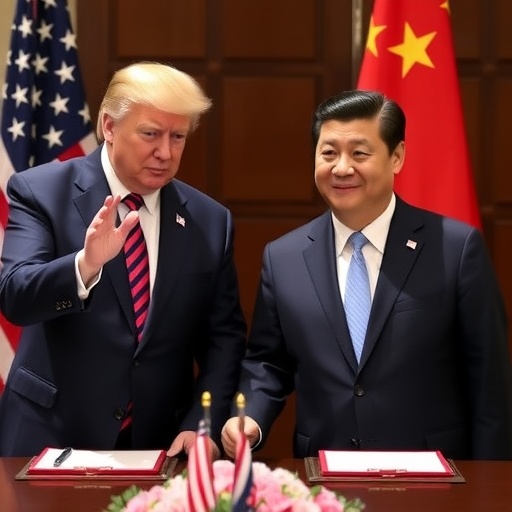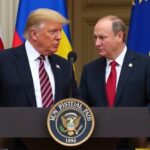US-China Trade Deal Nears Completion: Trump and Xi Jinping Set for Pivotal Summit Negotiations
In a dramatic turn that could reshape the global economy, the United States and China are on the verge of sealing a landmark US-China trade deal, with Presidents Donald Trump and Xi Jinping slated to convene at an upcoming summit to ink the agreement. Sources close to the negotiations reveal that after months of intense backchannel talks, the two superpowers have bridged key divides on tariffs, intellectual property, and market access, potentially averting a deeper trade war that has already cost billions.
The announcement comes amid heightened tensions, as the ongoing negotiation process has seen stock markets swing wildly and supply chains disrupted worldwide. Trump, known for his aggressive stance on trade imbalances, tweeted earlier this week: “Great progress with China – a deal that will bring jobs back to America!” This development signals not just economic relief but a possible thaw in the frosty relations between the two nations, which have dominated headlines since the trade disputes escalated in 2018.
According to White House officials, the summit is tentatively scheduled for next month in a neutral location, possibly Singapore, echoing the site of their 2018 meeting. The deal’s scope is ambitious, addressing over $300 billion in annual trade flows and aiming to reduce the U.S. trade deficit with China, which stood at $419 billion in 2018 before partial tariffs kicked in.
Breaking Down the Core Elements of the US-China Trade Deal
At the heart of this emerging US-China trade deal are provisions designed to level the playing field for American businesses. Negotiators have reportedly agreed to slash tariffs on $200 billion worth of Chinese goods, including electronics and machinery, in exchange for Beijing’s commitments to curb forced technology transfers and enhance protections for U.S. patents.
One surprising angle is China’s pledge to increase agricultural purchases from the U.S. by $40 billion annually, a boon for Midwestern farmers who have suffered from retaliatory tariffs on soybeans and pork. “This isn’t just about numbers; it’s about restoring faith in fair trade,” said U.S. Trade Representative Robert Lighthizer in a recent briefing. Data from the U.S. Department of Agriculture shows that soybean exports to China plummeted 75% during the height of the trade spat, underscoring the human cost behind the statistics.
Intellectual property reforms form another pillar, with China agreeing to establish a specialized court for IP disputes and impose steeper penalties for theft – issues that have long irked Silicon Valley giants like Apple and Qualcomm. Estimates from the U.S. Chamber of Commerce peg annual losses from IP infringement at $225 billion to $600 billion, making these concessions a hard-won victory for Trump’s administration.
Financial services access is also on the table, allowing U.S. firms like JPMorgan Chase greater entry into China’s $40 trillion banking sector. This could unlock billions in investment opportunities, but experts caution that enforcement mechanisms will be crucial to prevent backsliding.
Trump’s High-Stakes Gamble in US-China Negotiations
President Trump’s approach to the US-China negotiation has been a rollercoaster of brinkmanship and bold proclamations. From imposing 25% tariffs on steel imports to labeling China a “currency manipulator,” his tactics have pressured Beijing into concessions that eluded previous administrations. Yet, this deal represents a pivot, as Trump seeks a legacy-defining win ahead of domestic political battles.
Insiders describe the talks as marathon sessions, with U.S. teams shuttling between Washington and Beijing. A key breakthrough came last week when Xi Jinping personally intervened, reportedly assuring Trump during a phone call that China would prioritize “mutual respect” in economic ties. This personal diplomacy harks back to their Mar-a-Lago summit in 2017, where initial goodwill quickly soured into tariffs.
Critics, including some in Congress, argue the deal falls short on structural reforms, such as state-owned enterprise subsidies that distort markets. “Trump’s deal-making flair is impressive, but we need ironclad enforcement,” warned Senator Chuck Schumer, a vocal advocate for tougher China policies. Polls from Pew Research indicate that 60% of Americans view China unfavorably, adding domestic pressure on Trump to deliver tangible benefits like job creation in manufacturing hubs.
Economically, the stakes are immense. The Peterson Institute for International Economics projects that a full resolution could boost U.S. GDP by 0.5% annually, while averting further escalation might prevent a global recession. Trump’s base, particularly in rust-belt states, stands to gain from revived exports, but failure could reignite accusations of empty promises.
Xi Jinping’s Strategic Concessions Amid Domestic Pressures
On the Chinese side, President Xi Jinping faces a delicate balancing act in these US-China talks. Yielding to American demands risks perceptions of weakness at home, where state media has framed the trade war as a defense against U.S. bullying. Yet, with China’s economy slowing to 6.1% growth in 2019 – its weakest in decades – Xi cannot afford prolonged uncertainty.
The deal includes commitments to open up sectors like cloud computing and biotech to foreign investment, potentially injecting $100 billion into the economy. Xi’s negotiators have emphasized reciprocity, securing promises from the U.S. to ease export controls on non-sensitive technologies. In a speech to the National People’s Congress, Xi stated: “We seek win-win cooperation, not zero-sum games,” a subtle nod to the summit’s importance.
Behind the scenes, China’s preparations are meticulous. State Council reports highlight internal reforms to align with deal terms, including anti-corruption drives targeting IP violators. However, analysts from the Brookings Institution note that Xi’s authoritarian style allows swift implementation, but it also breeds opacity – a factor that has frustrated U.S. counterparts throughout the negotiation.
Public sentiment in China is mixed; a survey by the Chinese Academy of Social Sciences found 70% support for standing firm, yet urban consumers crave stable prices on imported goods. For Xi, the summit with Trump offers a platform to project strength globally, especially as China eyes leadership in 5G and electric vehicles.
Global Ripples from the Anticipated Trump-Xi Summit
The impending Trump-Xi summit is sending shockwaves through international markets, with implications far beyond bilateral ties. Asian stock indices surged 2-3% on news of progress, while European automakers like Volkswagen – heavily reliant on Chinese sales – breathed sighs of relief. The deal could stabilize supply chains disrupted by tariffs, benefiting everyone from iPhone assemblers in Shenzhen to Walmart shelves in the U.S.
Trade experts predict a domino effect: reduced U.S.-China friction might embolden multilateral efforts at the WTO, where reform talks have stalled. “This trade deal could be the catalyst for broader liberalization,” opined WTO Director-General Roberto Azevedo in an interview. Currency markets are also reacting; the yuan strengthened 1.5% against the dollar, signaling investor confidence.
Geopolitically, the agreement tempers fears of decoupling. Countries like Australia and Brazil, caught in the crossfire with falling commodity exports, stand to recover. A World Bank report estimates the trade war shaved 0.3% off global growth in 2019; resolution could add $200 billion to worldwide GDP by 2022.
Environmental angles emerge too, as the deal incorporates green tech exchanges, potentially accelerating joint efforts on climate change. Activists hail this as a silver lining, though enforcement remains a wildcard.
Looking ahead, the summit’s success hinges on ratification. If formalized, it paves the way for phased implementations over two years, with review mechanisms to address disputes. Trump and Xi’s personal rapport will be tested, but the potential for sustained dialogue offers hope for managing hotspots like the South China Sea. As negotiations wrap up, the world watches closely – this US-China trade deal could herald a new era of cooperation, or merely a truce in an enduring rivalry.








